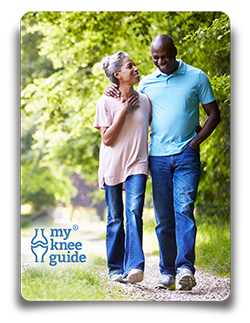
Recovery from knee replacement surgeryknee replacement surgery can be full of challenges along the way. We find that the patients who know what to expect after surgery, generally have excellent perspective on their progress and feel less anxious during their recovery period.
Knee Replacement Support Systems
It is extremely helpful to have a strong support network of family and friends during the critical period of recovery. My Knee Guide encourages patients to collaborate with us for encouragement and education during your recovery process.
- Read and contribute to our collection of StoriesStories from real patients that have gone through knee replacement surgery.
- We have a board certified orthopaedic surgeon who answers your questions on our social media sites: Twitter and FacebookFacebook.
- Find your daily motivational quotes on our PinterestPinterest pages to keep you going.
- For more in depth conversations with other knee replacement patients we also recommend the BoneSmart.org ForumBoneSmart.org Forum.
Early After Surgery
The first couple of days after surgery is typically the most uncomfortable. However, with the use of multi-modal pain controlmulti-modal pain control around the time of surgery, patients are frequently moving out of bed earlier and managing their pain more effectively. After discharged from the hospital, remember to stay ahead of the pain with ice, elevation, rest, and the judicious use of pain medicines.


Narcotic medicines can cause constipation and you may consider using ColaceColace as a daily stool softener, and DulcolaxDulcolax suppositories as needed to to stimulate a bowel movement.
It is important to realize that many narcotics preparations contain acetaminophen, which limits the amount of medicine that can be taken safely. Learn more about which post-op pain medicines contain acetaminophenpost-op pain medicines contain acetaminophen. Some patients will continue to use narcotic pain medicines to some degree for 4-12 weeks after surgery. It is common for doctors to wean patients down in regards to the amount and frequency of narcotics over time. During their recovery, patients should try to gradually limit their use of narcotics to balance pain and their rehabilitation progress.
You many also need to avoid other pain medicines such as NSAIDsNSAIDs early in the post-operative period if you are concurrently on a blood thinnerblood thinner to reduce the chance of blood clotsblood clots.
Ice and Elevate
The knee will typically be swollenswollen early after surgery and can be uncomfortable. There is a true balancing act between the need to keep the knee moving versus worsening swelling and pain. Remember to ice and elevate the knee during this time. Some surgeons will have their patients use a “cold machine” that can circulate icy water around the knee. The use of ice packs can also provide similar results. We recommend larger packs that can drape over the knee.
Here is how to create your own homemade ice packs. Make four of these packs before surgery and have them stored in the freezer for frequent use:


- Use one gallon food storage bags (such as Hefty® or Ziploc®). You may consider double bagging to prevent leaking
- Add 1 cup of rubbing alcohol (70% isopropyl alcohol)
- Add 3 cups of water
- Add a small amount of food coloring if desired
- Evacuate all the air from the bags before freezing
- Place in the freezer. Initial freezing will take 5-6 hours
These ice packs will freeze into a slushy state that can easily be molded around the knee. Remember to place a soft thin cloth between the ice pack and the skin to prevent frost bite. Re-apply the ice packs frequently while the knee is swollen.
Recovery up to six weeks
Initially, it is very common for patients to have trouble getting a restful night sleep. This is due to the knee being unconfutable and swollen. Some surgeons will want their patients to wear a brace to bed for several weeks to help reduce the chance of developing a flexion contractureflexion contracture of the knee. A good night's sleep will return over time. Check with your physician if medication is recommended as a sleep aide. Some patients can consider over the counter Benadryl® to assist with sleep.


Traveling during the first 3 weeks after surgery should be limited to certain activities such as going to an out-patient physical therapyout-patient physical therapy program. Some patients may opt for home based physical therapyhome based physical therapy in the early recovery period to reduce the need for traveling. Patients may still have difficulty getting in and out of the passenger side of a car at this stage. Driving should be avoided during this time.
By the time you reach the third week, the most significant pain will fade. Deep aching becomes more prominent rather than sharp pain. Most patients will start to feel comfortable returning to drivingreturning to driving approximately 4 to 8 weeks after surgery. We recommend to avoid longer trips for up to 6 weeks following surgery.
During this phase, the knee can still feel quite tight at times. Some days will be better than others. During the first 6 weeks, the knee will still need "ice, elevation, rest and exerciseexercise."
It is not unusual for some patients to feel a transient sense of the “blues” or depression during this period of time. This will improve as the knee continues on its recovery process, and as sleep patterns begin to return to normal.
Recovery from 6 – 12 weeks
By six weeks after surgery many patients are now experiencing less pain than they did before surgery and it becomes much easier to visualize the end result. At this time it is common for patients to have noticed that their knee may click or clunk. This noise or sense of instability is caused by some minor motion between the thigh bone prosthesisprosthesis and the plastic component attached to the shin bone. This is usually normal and may become less noticeable as the patient develops better strength in the knee. This increase in strength will help control the position of the components during the normal arch of motion.
Most patients will have finished their formalized therapy by the end of this stage of recovery and will have transitioned to performing an unsupervised exercise program. This period is usually when the results of all your efforts are beginning to be realized. Patients who have "light duty" jobs, typically can return to workreturn to work between 6 and 12 weeks.
For some patients, it may take up to twelve weeks to feel as if they are "better than before surgery." At 12 weeks after surgery there typically will still be some knee discomfort and minor swelling.
Recovery after 12 weeks
After three months, routine activities become easier. You typically will feel much more functional than you have in a long time. After six months, most of the healing has completed. Occasional aching or soreness is still common. It may take nine months to a year before the sense of stiffness fully resolves. Significant pain from the knee replacementpain from the knee replacement during this period should be evaluated by your orthopaedic surgeon.














